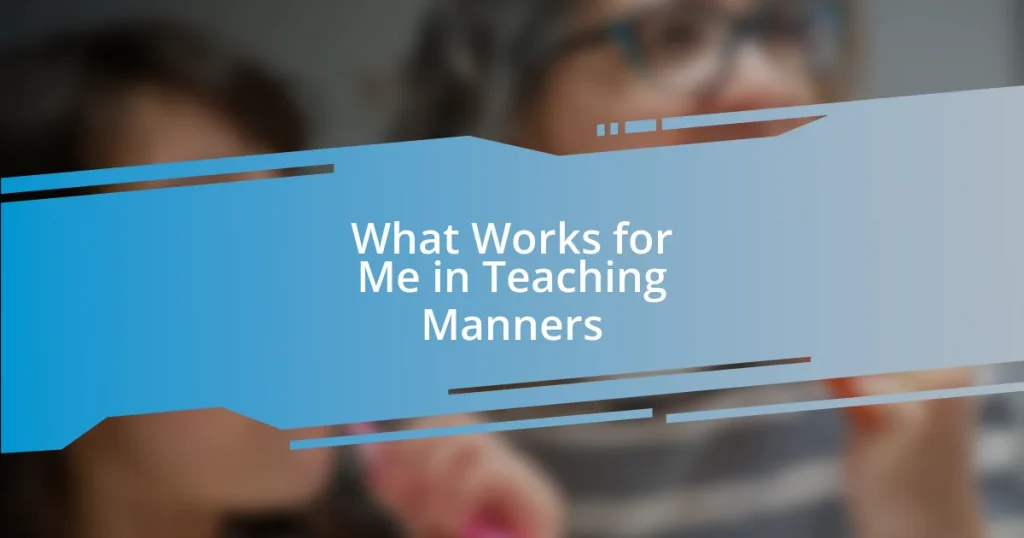Key takeaways:
- Encouraging child creativity involves nurturing their imagination through unstructured play and allowing space for exploration and mistakes.
- Creating a stimulating environment with accessible art supplies and engaging in outdoor exploration significantly enhances a child’s creative expression.
- Celebrating unique ideas and the creative process promotes a child’s confidence, helping them appreciate their efforts and develop a resilient mindset towards problem-solving.

Understanding Child Creativity
Understanding child creativity goes beyond simply recognizing artistic talent; it’s about nurturing their innate wonder and curiosity. I remember the first time my child transformed a cardboard box into an elaborate spaceship. In that moment, I realized how vital it is to provide opportunities for imaginative play. Have you ever watched a child completely lose themselves in their own creations? It’s magical.
Children express their creativity in unique ways, often reflecting their thoughts and emotions through play and art. I’ve noticed that when my child draws, they aren’t just putting colors on paper—they’re communicating their feelings, whether it’s joy or uncertainty. Isn’t it fascinating how a simple crayon can become a tool for self-exploration?
Supporting child creativity means allowing for mistakes and experimenting without judgment. I often sit back and observe my little one as they try and fail, then try again. This process is invaluable; it’s where true problem-solving begins. Have you seen how resilient kids can be? That resilience is a beautiful aspect of their creative development.

Identifying Your Child’s Interests
Identifying what sparks your child’s interest is crucial in nurturing their creativity. I remember a time when my daughter couldn’t get enough of watching nature documentaries. Her fascination with animals led us to spend weekends exploring local parks and trying out different art projects inspired by what she’d seen. This exploration not only encouraged her curiosity but also showcased how important it is to pay attention to their spontaneous interests.
To help pinpoint your child’s interests, consider these pointers:
– Observe their playtime: What themes or characters do they gravitate towards?
– Explore various activities: Try different crafts, sports, or music; see what excites them the most.
– Ask open-ended questions: Instead of yes/no inquiries, ask things like, “What’s your favorite part about drawing that?”
– Share your interests: Invite them to join you in your hobbies and see if they take an interest.
– Give them time: Sometimes, their interests evolve; allow them space to explore at their own pace.
Each child is unique, and the joy lies in discovering what truly captivates their imagination.

Creating a Stimulating Environment
Creating an environment that stimulates creativity in children is essential. I often rearrange spaces in our home to make them feel new and exciting. For instance, transforming a corner of the living room with soft cushions and colorful fabrics inspired my child to create their own little reading nook. It’s amazing to see how a simple change in space can spark imagination and invite them to dream freely.
Having art supplies readily available is another powerful way I encourage creativity. I dedicated a shelf in our playroom for various materials—crayons, paints, and recycled items. The delight on my child’s face when they discovered new tools was priceless. It’s as if those supplies became magic wands, empowering them to bring their ideas to life. Have you ever watched a child dive into an art project, their concentration palpable? That’s the moment I know I’m supporting their creative journey.
I also make it a point to include outdoor exploration in our routine. Nature itself is a masterpiece, and I’ve found that the sights, sounds, and textures ignite my child’s creativity. During our walks, we often gather leaves or interesting stones. Later, we use them in art projects. This not only fosters appreciation for the outdoors but also allows their creativity to flourish using elements from their environment. Being immersed in nature, I believe, plays a crucial role in how children see the world and their place in it.
| Aspect | My Approach |
|---|---|
| Environment Setup | Rearrange spaces to inspire new activities, creating cozy nooks or open areas. |
| Available Materials | Stock affordable art supplies and encourage exploration of new tools. |
| Outdoor Engagement | Incorporate nature walks for creative inspiration, using found objects in projects. |

Encouraging Free Play and Exploration
Encouraging free play and exploration is something I truly value in my parenting approach. I remember a sunny afternoon when I let my son loose in our backyard with nothing but a few cardboard boxes and some tape. It was fascinating to watch him transform those simple materials into a spaceship, his imagination propelling him on an intergalactic adventure. Can you think of a time when you saw your child wholeheartedly engaged in playful exploration? Those moments are golden.
One thing I’ve learned is the beauty of unstructured play. There are days when my daughter and her friends just set up an impromptu scavenger hunt in the park, searching for unique leaves, funny-shaped rocks, and even bugs. I often find myself marveling at their ability to create games on the fly. It’s profound how free play can foster problem-solving skills and teamwork, giving them the freedom to discover the world through their lens.
I also try to resist the urge to intervene too quickly when they’re figuring things out during playtime. I once observed my son struggling with a fort he was building. Instead of jumping in to help, I sat back and watched him figure out how to balance the blankets. Not only did he eventually succeed, but the pride on his face was priceless. It really struck me that sometimes, just stepping back allows them to own their experiences, leading them to feel more capable and creative. Have you ever noticed how that sense of achievement boosts their confidence? It’s a powerful lesson in independence.

Incorporating Arts and Crafts Activities
Incorporating arts and crafts activities into our daily routine has become a joyful tradition in our home. I remember one rainy Saturday when we decided to make colorful collages using old magazines. My child was so absorbed, cutting out pictures and arranging them into delightful scenes. Watching their concentration reminded me of how powerful art can be in expressing thoughts and feelings that may be hard to put into words.
I also find that hosting themed craft sessions can ignite even more creativity. A few months back, we had a “Space Day,” where we made everything from rocket ships out of paper towel rolls to glittery star decorations. Seeing my child’s eyes light up as we painted planets together was a moment of pure connection. Have you ever noticed how such themed activities can really spark enthusiasm? It’s as if a tiny world of inspiration unfolds right in front of us.
It’s crucial to remember that the process is just as important as the end result. When my daughter brought home a painting from school, it was a mix of vibrant splashes and curious shapes. Instead of focusing on what the painting “should” look like, I celebrated the effort and imagination she poured into it. Encouraging this mindset fosters a love for creativity without the pressure of perfection. What better gift can we give our children than the ability to enjoy the journey of creation?

Supporting Creative Problem Solving
Supporting creative problem-solving in my child’s life is a journey I embrace wholeheartedly. For instance, I recall a weekend camping trip where my son faced a challenge: how to create a makeshift shelter after our tent blew down. Instead of stepping in immediately, I encouraged him to brainstorm solutions. Watching him gather materials — branches and tarps — and collaborate with friends to innovate reminded me of the resilience children possess. Challenges like these are opportunities in disguise.
I’ve also learned the importance of asking open-ended questions during these problem-solving moments. One evening, while my daughter was frustrated with a puzzle, I asked, “What else can we try?” That simple prompt sparked a flurry of ideas. She began to rearrange the pieces in bold new configurations. Encouraging them to think outside the box, even in small ways, nurtures a mindset that embraces challenges as invitations for creativity. Have you ever noticed how that shift in perspective can truly unleash their potential?
Empowering my children to tackle problems independently has been incredibly rewarding. There was a time when my daughter wanted to bake cookies but realized we were out of eggs. Instead of despairing, she suggested using applesauce as a substitute. I was taken aback by her creativity! Not only did the cookies turn out delicious, but it also reinforced her ability to adapt and think innovatively. Isn’t it exciting to witness those lightbulb moments where a child discovers their own capabilities? The pride that comes from solving a problem fuels their confidence, and it’s a reminder for me to always celebrate their unique solutions.

Celebrating Unique Ideas and Achievements
Celebrating my child’s unique ideas and achievements is one of the highlights of my parenting journey. Recently, my son decided to create a comic book featuring characters he invented. When he finished, I threw a mini-release party at home, complete with snacks and a “red carpet” for him to present his work. Seeing his face light up as he shared his story with our family was a powerful reminder that recognition can fuel creativity and self-expression.
I often find that even small accomplishments deserve celebration. The other day, my daughter wrote a poem about her favorite tree in our backyard. Instead of merely praising the words, I suggested we record her reading it aloud. Hearing her voice return to her own work was a transformative moment, reinforcing her love for writing. Have you noticed how the act of sharing our creations can create lasting memories? It’s those moments where we bring ideas to life together that truly resonate.
Additionally, I make it a priority to highlight the efforts behind the creations, not just the end products. I remember a time when my child struggled to paint a scene for school. Instead of focusing on the final piece, we took time to reflect on the techniques and ideas that shaped it. Asking questions about her process, like “What made you choose those colors?” led to a deeper appreciation of the journey. Fostering this dialogue nurtures their pride in experimentation. Isn’t it magical when children realize their creative process matters just as much as the outcome? Celebrating both the ideas and the hard work helps build a resilient foundation for their artistic endeavors.
















